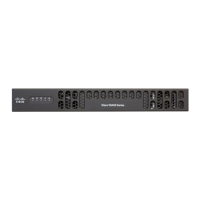3. service
4. shutdown
5. preference
The port subcommand specifies what ports to configure for a specific group command. It has the following
formats:
port <voice port#> [ans | called | dest] <E164 address> [desc <description>]
port <voice port#> [desc <description>]
port <voice port#>
port <start voice port#>-<end port#> [ans | called | dest] <E164 address> <interval>
[desc <description>]
port <start voice port#>-<end port#> [ans | called | dest] <E164 address> [desc
<description>]
port <start voice port#>-<end port#> [desc <description>]
port <start voice port#>-<end port#>
port all [ans | called | dest] <E164 address> <interval> [desc <description>]
port all [ans | called | dest] <E164 address> [desc <description>]
port all [desc <description>]
port all
• The voice port# is composed of slot#/subunit#/port# or slot#/port#.
• The ans is the abbreviation for answer-address, which has the same meaning as the subcommand under
dial-peer voice <tag> pots.
• The called is the abbreviation for incoming called-number, which has the same meaning as the
subcommand under dial-peer voice <tag> pots.
• The dest is the abbreviation for description, which has the same meaning as the subcommand under
dial-peer voice <tag> pots.
• The <interval> denotes the interval value of the E164 number for each adjacent port. The default is
zero and the allowable value is from 1 to 100, inclusively.
• Multiple port commands are allowed and can be removed one by one with exact port specification or all
at once using no port all.
• No overlay port commands are allowed. As a result, no other port commands are allowed if port all is
configured.
Cisco VG400 Voice Gateway Software Configuration Guide
15
Configuring Voice Ports
Cisco IOS Bulk Configuration

